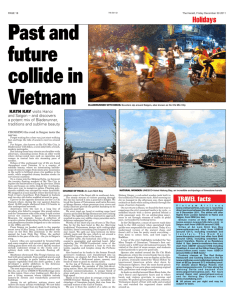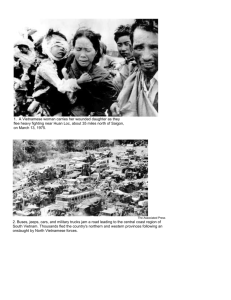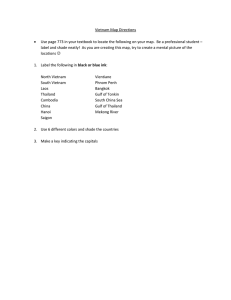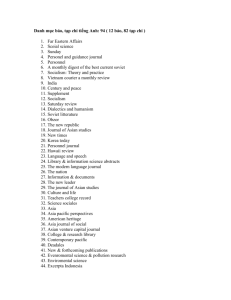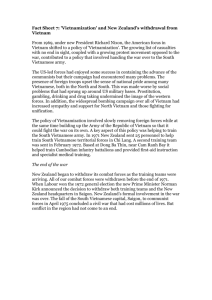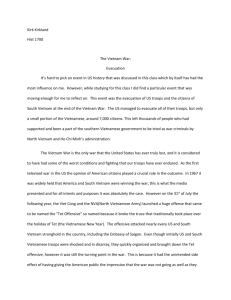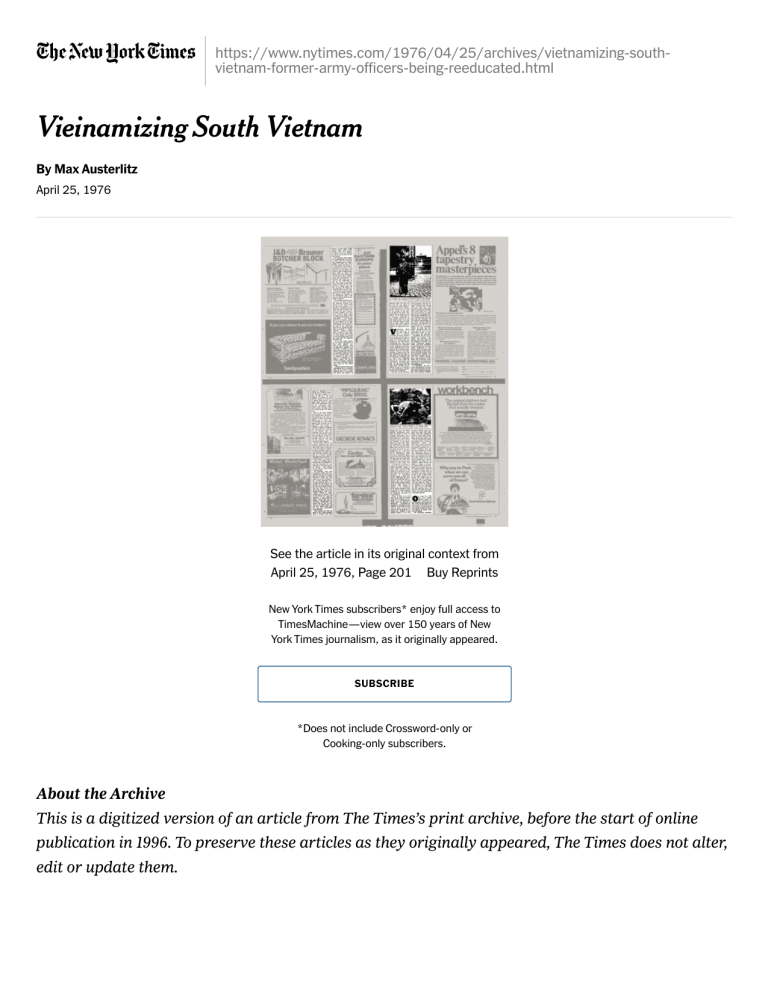
https://www.nytimes.com/1976/04/25/archives/vietnamizing-southvietnam-former-army-officers-being-reeducated.html Vieinamizing South Vietnam By Max Austerlitz April 25, 1976 See the article in its original context from April 25, 1976, Page 201 Buy Reprints New York Times subscribers* enjoy full access to TimesMachine—view over 150 years of New York Times journalism, as it originally appeared. SUBSCRIBE *Does not include Crossword-only or Cooking-only subscribers. About the Archive This is a digitized version of an article from The Times’s print archive, before the start of online publication in 1996. To preserve these articles as they originally appeared, The Times does not alter, edit or update them. Occasionally the digitization process introduces transcription errors or other problems; we are continuing to work to improve these archived versions. SAIGON, One year after the fall of the Thieu regime, Saigon is still a city in transition, half of it living in the past, the other half in a future partly undefined. The downtown bars are still mostly open, and in their empty dimness the bar girls still seem to be waiting for the return of their former patrons. The cafes, patterned on their Paris namesakes, are full. Lean youths in tapered shirts, long hair and flared jeans throng around the juke boxes, with their ceaseless blare of hard rock. Most of the French restaurants are still in business (though their French owners have left). and Saigon still offers the best cheese souffle and crepes flambees in Asia. The old bookshops have closed, but, thanks to the initiative of some enterprising merchants, literature for all tastes may be found spread neatly on the sidewalks—back copies of Playboy next to U.S. News & World Report, “The Gulag Archipelago” next to the Encyclopaedia Britannica, and a fair sampling of practically every book on Vietnam, in English or French, published over the past 30 years. The new bookshops that have been opened by the Provisional Revolutionary Government (P.R.G.) display the writings of Ho Chi Minh, Marx, Engels and Lenin, as well as traditional Vietnamese literature and Saigon's new crop of newspapers. These include a paper pub‐lished by the Saigon Revolutionary Committee; another published by an opposition figure under the old regime; a Chinese‐ language daily serving the Chinese ethnic community, and a Roman Catho‐lic weekly. The thieves’ market is still thriving, with transis‐tor radios, TV sets, stereo equipment, American records and other “preliberation” import items on sale at exorbitant prices. Cars and motorcycles have gone down in price, as a result of gasoline rationing; bicycles have gone up. At the central market, there is no shortage of goods or buyers. The whole city seems to be on a buying spree. Indeed, were it not for the absence of sandbags and barbed wire, and for the occasional portrait of Ho Chi Minh, it would appear to the casual observer that nothing had changed. The traffic is as chaotic as ever; an occasional child still begs on Tu Do Street; the English signs outside the bars and tailor shops remain untouched. This melange of old and new is the result of deliberate choice. “All problems are important,” explained one of the new leaders of South Vietnam, “but some are immediate and others can wait.” The Vietnamese Communists made a distinction between “the essential and the nonessential” after coming to power in the South, and, since April 30, 1975, Saigon has been undergoing a step‐by‐step process in which the revolution has been soft‐pedaled. In the first few weeks after the entry of Commu‐nist forces, Saigon lived in a state that sometimes bordered on chaos. North Vietnamese soldiers set up billets; P.R.G. cadres were in the process of identifying each other; Northern officials sent hastily from Hanoi were getting oriented, and the “304” was the scourge of the town. This—de‐riving from the numerals 30/4, for April 30—was the name the Saigonese had given to the “instant Communists” who emerged after the change of regime. They included a good number of petty crooks, whose favorite trick was to don black pajamas and go from house to house confiscating radios and TV sets in the name of “Socialist morality.” For a while it was not easy for the population to tell the real cadres from the impos‐tors. A few well‐publicized executions of looters soon appeared to bring the problem under con‐trol. Another problem was the vast amount of guns, hand grenades and other weapons that flood‐ed Saigon and other cities as the Saigon army disintegrated before the Communist advance. The authorities appear to have averted the potential danger to security by, a collection drive in which were turned in with no questions asked. Next came the registration of all former Govern‐ment officials and military personnel, most of whom had returned to their homes in the cities and villages, although a handful had taken to the jungle, where they resorted to minor banditry. Many of them hesitated to comply at first; those who did were given identity cards and advised not to change their domiciles. All but about 200,000 of the estimated 1.5 million persons affected were registered by June, and the “re‐education” process began. For privates and most noncoms, this consisted of three days of lectures. For former officers, it entailed much more. Some 70,000 of them were sent to camps in the countryside, for a lengthy course of lectures and discussion meetings. In Saigon, the rumor was that the officers in the re‐education camps would have their eyes gouged out or would be made to die of beriberi. When the North Vietnamese were in the outskirts of Saigon, the rumor was that they would chop off the fingers of all women with long nails. Twelve hours later, there wasn't a damsel with long nails left in the city. Since then, the nails have grown back to their former elegance.) The rumors of bodily harm in store for the officers have been squelched, but the re‐education process has taken longer than had been generally expected. A few officers have returned, but the majority are still in the camps. In 1954, Saigon's population stood at 500,000. By 1974, it had increased to more than three million, and the city had become unman‐ageable. On April 30, 1975, the economy of South Vietnam collapsed‐and with it the legal system, the public‐order apparatus, the schools and the postal services. All that was left was the cruel heritage of 30 years of war. To govern the country, the Communists set up Military Management Committees in all the prov‐inces, and a separate one for the Saigon area. In the provinces, control was turned over to civilians after a few months; Saigon, however, was a fester‐ing sore. Its swollen refugee population; the long years of unnatural dependence on imported raw materials; the warped market economy in which hoarding and the creation of artificial shortages by some businessmen had been the rule; the tens of thousands of orphans, cripples and prostitutes— all this made for a situation that was to tax the new authorities to the utmost. The Saigon Military Management Committee‐actually, seven of its 11 members were civilians‐remained in place as a precaution against potential disturbances and as a handle for the superlative administrative system of the North Vietnamese Army. The intervention of the N.V.A. in the city govern‐ment seems to have been dictated by necessity. The Southern‐based P.R.G. was well‐entrenched In the countryside, but it had only a skeleton organization in Saigon and no experience in manag ing large urban centers. Cadres had to be rushed in from the North. Some of them were Southerners, former Vietminh members who had moved North alter the 1954 Geneva Agreements and who now rediscovered a Saigon they hardly recognized. “I arrived in Saigon Iwo days after liberation,” said one of them, “and the first thing I did was to go and visit members of my family whom I had not seen for 20 years. I found them all, 18 of them, in the house of an uncle of mine, clustered in one room and shaking with fright. I asked them what was wrong. ‘We know the Communists are going to kill us,’ they said, ‘so we all came here so we would die together.’ I idld them to stop being foolish and to go back to their homes.” “For 10 days.” the official added, “they were a state of bliss. Today, all they do is complain. Not enough gas, the shops are running out of soda water, they no longer get the latest French fashion magazines.. ..” The Saigon city government is now staffed by a mixture of P.R.G. cadres, Southern “returnees” from the North, Northerners of the Hanoi mold, and a sprinkling of former Saigon technical person‐nel trained in American methods. The combination has worked surprisingly well. At the Saigon airport, for instance, the former ground personnel and meteorological staff are back at work under the direction of North Vietnamese supervisors, and the lumbering C‐1:10's, on which the Saigon emblem has been replaced by the North Vietnamese star, are given their landing instructions by the same American‐trained air‐ traffic controllers who op‐erated the control tower during the days of Presi‐dent Thieu. A good way to understand how the Saigon city government goes about (Continued on Page 98) its task is by studying the organization of one of the 11 districts into which the greater Saigon area has been divided. The Son My Tay district lies in the outskirts of Saigon. It has a score of industrial plants, including four cotton mills, a sugar refinery, a pro‐ducer of native drugs and an ice‐making factory, and some small—mostly family‐run‐food stores, carpenter shops, repair shops and the like. There were at most 100,000 inhabitants in Son My Tay in 1965; by the late 60's the tumiber reached 200,000. Son My Tay is adminis‐tered by its own Revolution‐ary Committee, under the guidance of the overall city management group. The com‐mittee oversees the work of nine departments, in such areas as the economy, educa‐tion, information and culture, public security, health and welfare and other concerns. Apart from that, the district is divided into subdistricts of 10,000 to 20,000 people, which are subdivided into sectors of up to 5,000 peo‐ple, which are further subdi‐vided into “solidarity units” of about 20 families apiece. Overlapping these subdivi‐sions are any number of as‐sociations of teachers, intel‐lectuals, shopkeepers, young people, women, workers, re‐ligious groups and so on. Within this system, the indi‐ vidual becomes part of a web of mutual responsibilities. For instance, at the simplest level, sanitation in Saigon's back streets is now the responsi‐bility of the “solidarity units,” operating through the local workers', young people's and womeans’ associations. The chief problems in Son My Tay were economic. The unemployment rate in the months after “liberation” reached 70 percent—a refiec‐tion of a situation on the national level in which more than three million people, in‐cluding about one million military, became jobless over‐night a year ago. Economic recovery in Son My Tay has been facilitated by the ab‐ sence of large industries de‐pendent on imported raw ma‐terials, Except for one plant, all the industries in the dis‐trict were privately owned under the former regime, and still are. “Our policy,” said Chi Hieu, chairman of the Son My Tay Revolu‐tionary Committee, “consists, first, of normalizing life with‐in our district, and, second, of assisting those who were displaced by the war and had to move to the city to re‐turn to their homes in the countryside.” “Return to the countryside” —everything in the new lead‐ers’ plans hinges on that. Be‐ tween 1965 and 1975, approxi‐mately 10 million South Viet‐namese—more than half the population of the country—were displaced from their vil‐lage homes. The rural popula‐tion decreased from 85 per‐cent of the total to 47 percent. While some of the villagers moved from one rural area to another, the major dis‐placement was from the coun‐tryside to the cities. More than five million of the ref‐ugees are today crowded in the cities—Saigon, Danang, Nha Trang, Hue, My Tho, Vung Tau—where they are partly or totally out of work. The new Government is faced with the problem of not hav‐ing enough farmers to till the land, and too many urban residents who are out of work or who have skills of little use to the economy. Rural resettlement, an oper‐ation of staggering propor‐tions, is being implemented along two lines. One is called “return to the village of ori‐gin.” This will affect those displaced persons who have maintained roots — family, some property—in their birth‐places. While the Government is providing some help, this program does not require major effort, as people will be returning to areas where they already have some eco‐nomic foundation. However, in many cases the original village has been totally destroyed, togethor with the ancestral tombs, and the land has lain untended. with the result that the dis‐placed persons have lost their attachment to the place. In other cases, the village does not have enough arable land to support the returnees with their enlarged famliies. So a twin program is the establish‐ment of rural “areas of new economy,” where displaced persons who don't want to go back to their old villages can be resettled and rehabili‐tated, and where new oppor‐ tunities can be offered for volunteers. Across the map of South Vietnam, “areas of new eco‐nomy” have been drawn up in a leopard‐spot pattern. Ge‐nerally, they are areas that either had been or had be. conic underpopulated. For ex‐ample, the district of Cu Chi near Saigon had 36,000 inhab‐itants in the early 60's. By 1973 the population was down to 600. Plans now call for the resettlement and rehabilita‐tion of 48,000 displaced per‐sons in Cu Chi within the next two to five years— half of them people who were from the district originally. Some of the villages were totally destroyed, and will be rebuilt on their former sites. In Vietnam, a village usually consists of a cluster of ham‐lets covering an area of up to 25,000 acres and hous‐ing about 1,000 families, or 5.000 to 8,000 inhabitants. About 500 villages are to be rebuilt. A displaced person is given a choice of returning to his village, whether inside or outside an area of new economy, or moving to a new location inside such an area. A lot must be done before such a zone is ready to re‐ceive the refugees. First, the mines and unexploded ord‐nance must be disposed of and the bomb craters must be filled. Then, a start must be made on reclaiming the land, restoring the wells, lay‐ing new roads and building the houses, medical centers and other facilities. Only then will the displaced persons be‐gin to arrive—and to assist in the subsequent work of Each family that moves in receives a basic kit of farming and cooking utensils, mosqui‐to netting and other rural necessities, as well as enough food to last it until the first harvest. Each family is also given 10,000 square meters (about 2.5 acres) of land. The family will have deeds to the land, but any part of the crop it wishes to sell must be sold to the state at fixed prices. In addition, however, each family will be given a “private plot” of 300 square meters (about 3,230 square feet), the produce of which it will be allowed to sell at free prices on the free market. The program, which began to be implemented at the end of 1975, calls for resettling and rehabilitating five million people over the next three to five years. Of these, it is expected that three million will move to areas of new economy and two million will return to their villages outside those zones. In every city district, the local Revolution‐ary Committee has a “rehabili‐tation and resettlement” de‐partment that fosters the re‐turn to the countryside. In Son My Tay, for instance, more than 8,000 people have already moved out. For Sai‐gon as a whole, plans call for resettling 1.5 million in‐habitants by the end of 1976. The question could naturally arise as to whether there is an element of coercion in the resettlement policy. The answer could perhaps be best All available statistics indi‐cate that the great bulk of the displaced persons who moved to the cities during the war were farmers. It is obvious to anybody who has spent any time in South Viet‐nam that the great majority of these refugees, who have been living in urban slums, are eager to go back to their accustomed environment—the countryside — and resume their lives as farmers. Indeed, all the evidence on the spot indicates that so far, at least, more people have applied to go back to the countryside than the new regime has been able to process. It would, therefore, appear unlikely that, at least at this stage, the Government would want to coerce people into moving to the countryside while there are long lists of volunteers waiting to go. As to what might happen in the future, speculation at this point appears pre‐mature. But certainly, from its gradualistic approach and the form it seems to have taken thus far, the South Viet‐namese resettlement program is markedly different from the more radical process that is reported to have taken place in Cambodia—as the origins, hature and history of the Vietnamese revolution have been markedly different from those of the Khmer Rouge. Another question that could legitimately arise is whether, after all the years of bitter fighting, there is any retribu‐tion under way against the defeated side. All that can be said with any degree of certainty by a Western observ‐er who has spent a compara‐tively limited span of time in the country is that there is no sign of any major retri‐bution and no rumors to that effect. At the same time, it is obviously impossible for any outside observer to see the whole country. And while this limitation applies equally well to many other nations. caution was and remains a requisite in reporting on Viet‐ nam. Vietnamese, North’ and South, go to the polls today to elect a National Assembly for all of Vietnam. It is the first formal step to‐ward reunification of the two parts of a country that was divided by the 1954 Geneva Agreements into what were to have been two “temporary zones” pending national elec‐tions in 1956. From the stand‐point of the Vietnamese Com‐ munists, they are now imple‐menting a process they feel was aborted 20 years ago. As Mr. Hieu, of the Son My Tay Revolutionary Committee, put it, “You must understand that for us, since 1945, the Vietnamese revolution was one. We are all Vietnamese and we all fought for the same ideal. So what does it matter if one of us was born in one Vietnamese province rather than in another" Thus far, all the provinces of the country, from the Ca‐mau Peninsula in the extreme south to Lang Son in the far north, have been rede‐signed, bringing the combined total down from 62 to 34. The two provinces on either side of the 17th parallel have been joined, symbolically, into one. Probably some time this year, the two Vietnams will be joined by proclamation of the newly elected National Assembly, and unification on the state level will be com‐pleted. But the succeeding phases of social and eco‐nomic unification will pro‐ceed, step by step, for an unspecified length of time. The reasons are pragmatic. Throughout the war years, inflation was endemic in the South, and currency was printed with little regard to the economic situation. The South Vietnamese piasters, which had been oscillating at around 700 to the American dollar, plummeted in the months before the fall of the Thieu regime to a black mark‐et rate of 5,000. By May 1975, the currency's backing had dissolved to nothing. To pre‐vent the South's inflation from being exported to the North, the two halves of the country had to be sealed from each other, in terms of finan‐ cial transactions. In September, the Provi‐sional Revolutionary Govern‐ment announced that the Sai‐gon piaster would be replaced by a new currency. Everyone would be permitted to ex‐change up to 10,000 old piast‐ers into new piasters at a rate of 500 to 1; any old piasters in excess of that amount would be blocked in a special bank account until their origin could be estab‐ lished. Not surprisingly, news of the impending reform leaked, and wealthy Saigo‐nese started devising ways of circumventing the opera‐tion. One of the most original was to register at the French. run flOpital Grail. Patients in the first‐class w.trds were re‐quired to make an advance deposit for a 15‐day stay; on checking out, the unused portion was refunded. On the day before the currency ex‐change. a good number of well‐to‐do Saigonese suddenly fell sick and were admitted to the hospital. Once the exchange was in train, they were all miraculously healed and claimed the unused part of their deposit in the new currency. By the third day of the exchange, the first counterfeit bills appeared. On the whole, however, the currency exchange went off fairly smoothly, and the offi‐cials chose to turn a blind eye to the relatively few instances of petty cheating, which oc‐curred mainly in Saigon. This may have been because there will be a second currency exchange after the formal re‐unification of the country, and it also seems to be part of a policy of avoiding exacer‐bating fears or suspicions, so that the transition can pro‐ceed with a minimum amount of friction. This attitude can be felt in small things well as large. For instance, while most of Saigon's streets have been renamed, the new street signs give the old names in smaller characters under the new ones, so as to avoid confusion. On a more important level, the new officials seem to re‐cognize that the farmers who go hack to their villages are not the same simple country folk who came to the cities years ago. “Many of the dis‐placed persons.” said a high. ranking official In Hanoi, “picked up new habits. Some of the habits were bad and contrary to our traditions. Others were socially less sig‐nificant. They got used to electricity, refrigerators, soft drinks and the like. On this, there is no going back, and we well realize that there are now new requirements This touches on what ap‐pears to be a rather sensitive Issue in Vietnam these days. During the war, the North .suffered considerably more than the South in terms of material destruction, but it emerged with its social struc‐ture intact and its wealth—whatever there is of it—divid‐ed equitably. in the South, there are many more consu‐mer goods than in the North, but they are unevenly distri‐buted anti their cost in terms of social disruption has been tremendous. It is therefore hardly surprising that many of the revolutionary cadres who have returned to Saigon after an absence of more than 20 years have been profound‐ly disturbed by what they perceive as the cultural pros‐titution of their native It would be a mistake to regard this reaction as esson‐tially xenophobic. Many of these cadres are French‐edu‐cated, and schooled in the subtleties of French literature. Yet, while they have had no difficulty in assimilating French culture to their Viet‐namese upbringing, the super‐ficial but glaring Western in‐fluence that has pervaded many of the everyday aspects of life in Saigon leaves them repelled. This feeling is echoed in the Communist press, which constantly refers to the former regime's alleged uninterest in the fostering of Vietnamese literature, art and traditions. Thus, if there is a term that can be used to describe what South Vietnam is under‐going, it is Vietnamization. Apart from any political or Ideological considerations, Vietnam is reclaiming Its soul. Whether in the field of litera‐ture or music, or even the manufacture of goods for ev‐eryday use, Vietnam is now looking Inward to its own resources. Fifteen years ago, mats were made from reeds. These were then replaced by imported plastic strips. Today, mats in South Vietnam are again being made from reeds. On the national level, North and South face a series of fundamental choices. The North has a state or coopera‐tive economy; the South, for all practical purposes, has a market economy; how will the two economies be fused? The North has one of the hest educational systems in Asia; the schools in the South have just reopened; how will the young people of the two zones be raised to a common outlook? The North has an extensive health service; the South is facing a shortage of medical drugs, and is ham‐pered by the urban focus of its medical facilities; how will a reunified nation aspire to uniformity in health care? In the North, the major energy source is coal, of which there is an ample supply. In the South, the major source is oil, which has to be imported. While there is a good chance that oil might be found in the South, will the Vietnam of tomorrow be dependent on coal, on oil or on both? On that question alone, the choices to be made will neces‐sarily entail the involvement of foreign expertise. On June 27, 1975, the first foreign aircraft landed in the reopened Sai‐gon airport. It was a plane of the United Nations High Com‐missi on e r for Refugees (U.N.H.C.R.), inaugurating the first airlift of food and medi‐cal supplies to Saigon under the new regime. The emergency operation, launched in March 1975 under the aegis of Secretary General Kurt Waldheim, had been fly‐ing relief supplies for the Southern civilian population both to Saigon and to Hanoi (from where they were moved by road to the South). until the fall of Saigon disrupted air traffic to that city. Now, with traffic restored, all the airborne supplies were direct‐ed into Saigon. By the time the operation tapered off in August, it had delivered some 19,000 tons, and emergency assistance is estimated to have reached some 2.5 million Vietnamese. The reopening of the air link to the Qutside world was greeted with relief by the several thousand foreigners who had been left stranded in Saigon. The great majority of Americans had left the city before the entry of the Communist forces, but the French had stayed on. They included diplomats, business‐men and longtime residents of Vietnam, as well as several hundred teachers and techni‐cians who were there under the auspices of the French aid program. While there were no reports of any harassment of Westerners, the foreigners by June were out of work or out of money or both. The Saigon Military Manage‐ment Committee set up a spe‐cial department to expedite exit visas for foreigners, and some 500 of them, includ‐ing a number of Americans, were flown out by the U.N. With the end of the U.N. airlift, the French Government took over and chartered an aircraft, which now flies the Saigon — Bangkok route five times a week, principally for the purpose of bringing out Both U.N.H.C.R. and the United Nations Children's Fund have had programs in Viet‐nam since early 1974, cover‐ing the former Saigon re‐gime's areas, the P.R.G. areas and the North, and both agen‐cies now have offices in Hanoi and programs throughout the country. U.N.H.C.R. has also made its good offices avail‐able for other humanitarian purposes. Thus, it repatriated nine Americans who had been captured in the South and were released in Hanoi, and it flew out the bodies of three American pilots who had been listed as missing In action. The bodies were transported on the same U.N.H.C.R. air‐craft that brought to Hanoi a Congressional delegation headed by Representative G. V. Montgomery, Democrat of Mississippi, last December. Apart from U.N. assistance, which now includes programs of the World Health Organiza‐tion and the Food and Agri‐culture Organization, Vietnam is . receiving a much greater amount of help from individual countries on a bi‐lateral basis. The Soviet Union and China are still the major donors, but help is also coming from smaller nations. The Cubans have built a hotel in Hanoi and have repaired several roads. Sweden is building a paper mill. Some aid is also being given by private organizations such as the International Committee of the Red Cross, and by American religious groups such as the Quakers and Men Indeed, the end of the war has reopened Vietnam to the outside world. The Japanese company that built the Dan‐him Darn in South Vietnam was recently requested to continue its work. A French oceanographic vessel is map‐ping the seabed off South Vietnam, and ‐Vietnamese stu‐dents have been sent to coun‐tries like Australia and Switz‐erland. And the country's Communist leaders have indi‐cated that they envisage even‐tual joint ventures with West‐ern companies to develop the country's resources. The overriding preoccupa‐tion today, however, is with tasks of reconstruction that can only be accomplished by the Vietnamese themselves. “We won the war,” said a high‐ranking official in Hanoi, “and we will now prove to the world that we can win the peace.” What could well emerge from this effort is a new Vietnam of 45 million inhabi‐tants with qualities acknowl‐edged by both friend and foe, with considerable natural resources, with the best army in Southeast Asia, and with a profound sense of its nation‐al and cultural identity. Such a nation would be certain to play an increasing role in the world. IN
